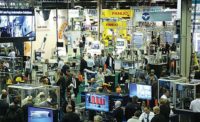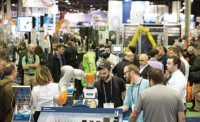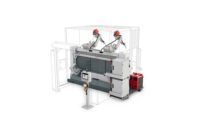More than 3,000 manufacturing professionals saw the latest robots, fastening tools and automation at the ninth annual ASSEMBLY Show, which was held Oct. 26-28 at the Donald E. Stephens Convention Center in Rosemont, IL.
The show featured 211 exhibitors spread across 61,200 square feet of floor space. Some 74 percent of the 2021 exhibitors renewed their booth space on-site for the 2022 show.
“It was wonderful to bring the industry back together safely in person and receive very positive feedback from the exhibitors and attendees who truly appreciate the focus of this event exclusively on assembly,” says Bill DeYoe, publisher of ASSEMBLY Magazine. “We look forward to welcoming back an even larger domestic and international audience to our assembly community next year when we return to Rosemont for our 10th anniversary event in October 2022.”
About 4,500 industry professionals from across the United States and around the world registered to attend the show. Attendees came from every industry covered by ASSEMBLY magazine, including such companies as 3M, Baxter Healthcare, Honda, Honeywell, John Deere, Kawasaki Motors, Kohler, Motorola, Northrop Grumman, Tesla and Yamaha.
The event kicked off with three workshops that attracted hundreds of attendees. Panelists for the “Electric Vehicle Assembly: Challenges and Opportunities” workshop discussed the important role that specific tools and techniques play in this assembly process. These technologies include battery leak testing, robotics and pulsed arc welding.
During the “Fastening and Joining: New and Alternative Methods” workshop, attendees learned that tried-and-true joining technologies like resistance spot welding are not always the best for new materials like composites, engineering plastics, aluminum and higher-strength, lighter-weight steels. Discussed alternatives include specialty adhesives like syntactic foams, clinching, self-pierce riveting, flow-drill screws and laser welding.
Panelists for “Robotics Assembly: Beyond the Basics” offered engineers several ways to apply robotics beyond simple pick-and-place operations and capitalize on the full capabilities of this technology. Artificial intelligence, vision guidance, automated screwdriving and cobot multitasking were all discussed in detail.
Editors from ASSEMBLY Magazine led dozens of attendees on six guided exhibit hall tours. Chief Editor John Sprovieri led the “Robotics” and “Fastening Tools” tours; Senior Editor Austin Weber led the “Autonomous & Electric Mobility” and “Industry 4.0” tours; and Senior Editor Jim Camillo led the “Pressing & Riveting” and “Automated Assembly” tours.
Subject matter experts from nearly a dozen exhibitors gave presentations at the show’s Learning Theaters in the exhibit hall. The sessions, which averaged 40 attendees, covered topics such as automation, automated guided vehicles, Cartesian robots, collaborative robots, robotic leak testing, motion control and error-proofing.
During the opening night “Taste of Rosemont” reception, high school students from PWNAGE Robotics team 2451 demonstrated the various robots they built, all of which use technology that is applicable for assembly. The team is based in St. Charles, IL, sponsored primarily by exhibitor Genesis Automation and competes in FIRST (For Inspiration and Recognition of Science and Technology) Robotics competitions internationally to gain real-world engineering experience.
A new feature at this year’s show was the Autonomous & Electric Mobility display, which featured the Zimmer Group gripper used to help build the Ford Mustang Mach-E. The display was presented by Autonomous and Electric Mobility, a supplement of ASSEMBLY Magazine that features news and products for mobility industry professionals focused on automated, connected, electrified and shared vehicle technologies.
Keynote Discusses Smart Manufacturing Strategies
Nearly every manufacturer has questions about Industry 4.0 (I4.0), but not all of them are equally important, noted Sudhanshu Gaur, vice president at Hitachi America and chief architect of smart manufacturing at Hitachi Astemo, in his keynote presentation, “Smart Manufacturing: Today and Tomorrow.” Gaur recommended company management address one question before all others: Do you know the necessary steps to take to properly implement your I4.0 plan?
When Gaur asked this question to the large audience in attendance, only one or two hands were raised. In contrast, every hand was raised a minute earlier when Gaur asked, “How many here have heard of I4.0?”
“New ways of data collection are now possible thanks to I4.0,” Gaur pointed out. “It also gives manufacturers new ways to use and benefit from this data.”
These include overcoming traditional challenges like optimizing overall equipment effectiveness, meeting dynamic market changes and closing the skills gap in workers. More and better data can also help companies meet challenges that have arisen since the onset of COVID-19, such as supply chain disruptions, a remote work force and cybersecurity concerns.
Gaur said that Hitachi Astemo has taken a three-prong approach to successfully implement its I4.0 program. The first part is “organization readiness.”
“For us, this involves establishing use cases, determining the necessary budget and ROI, and then ensuring internal alignment throughout the company,” explained Gaur. “After all, I4.0 must be an interdepartmental process to succeed.”
“Technology readiness” is step two. Gaur said that Hitachi Astemo achieved this by focusing on data readiness before implementing the necessary IIoT infrastructure. Only at that point was Hitachi Astemo able to obtain real-world and real-time insights into the company’s assembly applications, both simple and complex.
The third factor is “operational readiness,” which enabled Hitachi Astemo to obtain key process and worker-behavior insights that, in turn, lead to profitable outcomes. According to Gaur, this approach helped the company scale up its I4.0 plan from one line in a plant to all lines in a plant, and then from one plant to all plants.
Looking ahead, Gaur said that manufacturers must learn how to upgrade the skills of their current workforce and properly train new hires if they hope to successfully implement I4.0. He added that nearly 60 percent of these skilled labor positions remain unfilled.
“Something like 70 to 80 percent of smart manufacturing initiatives fail at various stages,” said Gaur. “More often than not, it’s not the technology that’s the bottleneck.”
Rather, according to Gaur, there often exists a huge gap between the intended beneficiaries of such initiatives—like the workers and supervisors—and the team that’s actually in charge of driving the initiatives. As a result, the voice of the end-users is not accounted for.
“To have a successful initiative, you need to bring all your stakeholders together to reach a consensus,” Gaur recommended. “This includes the IT, production, engineering and maintenance teams. Next, take baby steps, and figure out an iterative process. What are the use cases, and are they scalable? What is the ROI, and what technology is needed to obtain it?”
Prior to the keynote address, representatives from the GKN Automotive factory in Newton, NC, received the 2021 Assembly Plant of the Year Award from ASSEMBLY Magazine.
Product of the Year Winners
To draw attention to the breadth and quality of new technologies on display at The ASSEMBLY Show, we again held a “Product of the Year” contest during the event.
Twenty innovative products were nominated in five categories. Attendees voted for their favorites via tablet computers at a special display on the show floor. Voting was open during the first two days of the show, and the winners were announced the morning of Thursday, Oct. 28.
In the “Assembly Machines and Systems” category, the winning product was an automated production line from LANCO Integrated that assembles micron-sized parts. The line was developed to build three variants of a rice-size subassembly for a micro-electromechanical systems (MEMS) device used in consumer electronics and medical devices. Before this, the subassemblies were manually built. Design engineers knew that working at the micron level meant that every part of the process would be subject to movement that could not be seen. The line features a rotary dial, a pallet-transfer system, many compact work cells and 18 six-axis robots, which build subassemblies at a rate of 1,440 per hour with the help of machine vision.
In the “Adhesives, Dispensing and Curing” category, the winning product was Pallumina, an environmentally friendly pretreatment process from Henkel Corp. for metal car and truck bodies prior to painting. The process improves paint adhesion to the vehicle body while preventing corrosion. It is effective on all major metals, including 100 percent aluminum. Compared with conventional pretreatment processes, the new process cleans and prepares metal for painting in four steps rather than seven. The process also eliminates zinc, nickel and manganese phosphates, and reduces sludge generation by up to 90 percent. In addition, it requires 40 percent less energy and 50 percent less water.
Wera Tools’ 6004 Joker universal ratcheting wrenches won the “Fastening Tools” category. Each wrench automatically and continuously adjusts itself to tighten a range of fasteners in both metric and standard sizes. The hand tool comes in six sizes, covering a total range of 7 to 32 millimeters or 1/4 to 15/16 inch. At its resting state, the mouth of the wrench is at its smallest size. Pressing the tool onto the fastener causes it to automatically open and adjust precisely to the size of the fastener. When pressure is taken off the tool, it readjusts to grab either the point or flat of the fastener without needing to be removed from the fastener.
The ADHESO gripper from SCHUNK was voted the most popular product in the “Robotics” category. Inspired by gecko feet, the gripper consists of hundreds of fine polymer bristles that adhere to various materials without leaving a residue. It does not apply mechanical force to a part, but instead works on the principle of Van der Waals forces. To pick up a part, the gripper is gently pressed against it. The part is released by rotary, tilting or sliding movement, or with the help of an active wiper. Holes or interruptions in the workpiece surface are no problem. The gripper requires no external power, emits no particles and leaves no marks on the part when released.
In the “Factory of the Future” category, the winning product was a library of configurable apps, connectors and device drivers made by Tulip to help manufacturers accelerate their digital transformation. The company’s no-code frontline operations platform removes IT bottlenecks and enables citizen development of manufacturing software. This allows the teams closest to operations to own and update the systems that power their processes, while following company guidelines and fulfilling IT requirements. The apps also enable assemblers to create and configure software that elevates their processes without locking them into vendor-specific data models and static applications that require heavy customization.
Next year’s ASSEMBLY Show will be held Oct. 25-27, 2022. For more information, visit www.theassemblyshow.com.
















